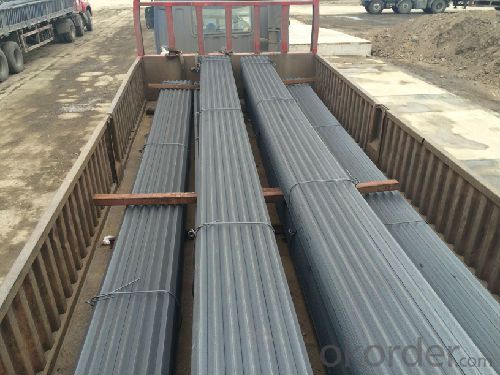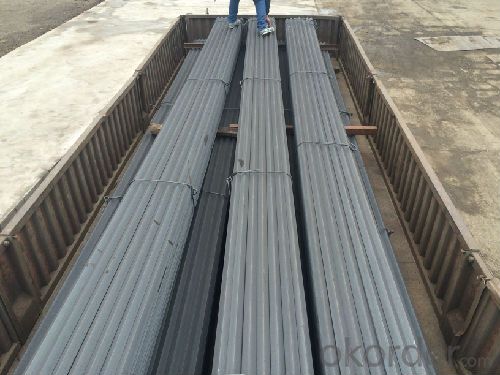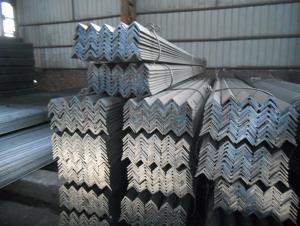Q345 angle, angle steel, galvanized angle steel
- Loading Port:
- Tianjin
- Payment Terms:
- TT or LC
- Min Order Qty:
- 25 m.t
- Supply Capability:
- 1000 m.t/month
OKorder Service Pledge
OKorder Financial Service
You Might Also Like
Item specifice
Product Description:
OKorder is offering Q345 angle, angle steel, galvanized angle steelat great prices with worldwide shipping. Our supplier is a world-class manufacturer of steel, with our products utilized the world over. OKorder annually supplies products to European, North American and Asian markets. We provide quotations within 24 hours of receiving an inquiry and guarantee competitive prices.
Product Applications:
Q345 angle, angle steel, galvanized angle steel are ideal for structural applications and are widely used in the construction of buildings and bridges, and the manufacturing, petrochemical, and transportation industries.
Product Advantages:
OKorder's Q235 Small angle, angle steel, galvanized angle steel are durable, strong, and resist corrosion.
Main Product Features:
· Premium quality
· Prompt delivery & seaworthy packing (30 days after receiving deposit)
· Corrosion resistance
· Can be recycled and reused
· Mill test certification
· Professional Service
· Competitive pricing
Product Description:
Angle called angle, the steel strip is perpendicular to each other on both sides into angular.Divided into equilateral angle steel and ranging from side angle. Two equilateral angle steel edge width is the same. The specification is expressed by edge width * width * thick edgenumber of millimeters. Such as "/ 30 x 30 x 3", namely that equilateral angle steel edge widthof 30 mm, 3 mm thick edge. Can also be used to model representation, model is the wideangle 3# cm, such as. The model does not represent the same type in different edge thickness size, thus in the contract and other documents on the angle of the edge width, edgethick size fill in complete, avoid alone represented by type. Hot rolled equilateral angle steelspecifications for 2#-20#. Angle according to the different needs of structure composed of a variety of stress components, can also be used as a component of the connections between the. Widely used in a variety of architectural and engineering structures, such as beams,bridges, towers, hoisting and conveying machinery, ships, industrial furnace, reactor,container frame and warehouse.
Mainly divided into equilateral angle steel, equilateral angle steel two categories, includingunequal angle can be divided into equal thickness and unequal thickness ranging from two.
Angle specifications with the side length of the size and edge thickness. At present, the domestic steel specifications for 2 - 20 cm in length, number of numbers, the same horn steel often have 2 - 7 different edge thickness. The actual size and inlet angle marked on both sides of the thickness and indicate the relevant standards. The general length of more than 312.5px for large angle steel, 312.5px - 125px for the medium angle, length of 125px for smallangle.
Inlet and outlet angle steel orders generally required the use specifications in the steel,carbon structural steel grades as appropriate. Is the angle in addition to standard number, nospecific composition and performance series.
Angle steel delivery length is divided into fixed length, size two, domestic steel length range is3 - 9m, 4 12M, 4 19m, 6 19m four range according to different specifications. Japanese steellength ranges from 6 to 15m.
Section of unequal angle height according to the long edge of the width to calculate the non equilateral angle steel. Refer to section angle and side length is not equal to the steel. Is a kind of angle steel. The length from 25mm * 16mm to 200mm * l25mm. By the hot rolling mill rolling in. General scalene angle steel specifications: thickness of 4-18mm / 50*32-- / 200*125
Equilateral angle steel is widely used in all kinds of metal structures, bridges, machinery manufacturing and shipbuilding industry, all kinds of architectural and engineering structures,such as beams, bridges, towers, hoisting and conveying machinery, ships, industrial furnace,reactor, container frame and warehouse etc.
FAQ:
Q1: Why buy Materials & Equipment from OKorder.com?
A1: All products offered byOKorder.com are carefully selected from China's most reliable manufacturing enterprises. Through its ISO certifications, OKorder.com adheres to the highest standards and a commitment to supply chain safety and customer satisfaction.
Q2: Can fit in the containers of 20fts the steel beams of 6M?
A2: No proble, we can put them into the containers in the form sideling.
Q3: The products are invoicing on theoritical weight or on actual weight?
A3: We can do it in both manners, according to the customers' request.
Images:


- Q:What are the common design codes or standards for steel angles?
- Structural design of steel angles is governed by various design codes and standards, which guarantee their compliance with safety and performance criteria. The American Institute of Steel Construction (AISC) Manual of Steel Construction is widely recognized as a crucial design code for steel angles. This manual offers comprehensive guidelines and specifications for the design, fabrication, and erection of steel structures, encompassing angles as well. It provides intricate details regarding design strength, allowable stress levels, and geometric properties of angles. Besides the AISC Manual, other design codes and standards may also apply depending on the specific project and location. These include internationally recognized standards such as the Eurocode, British Standards (BS), and Australian Standards (AS). Each of these standards may have slight variations in their requirements for steel angle design and utilization. Therefore, referring to the relevant standard for a specific project is of utmost importance. Moreover, the American Society for Testing and Materials (ASTM) has established standards for the physical and mechanical properties of steel angles. These standards guarantee that the angles satisfy certain quality and performance requirements. Among the most commonly utilized ASTM standards for steel angles is ASTM A36, which outlines general requirements for carbon structural steel. To ensure structural integrity and reliability, common design codes and standards for steel angles provide guidance on crucial factors such as load capacity, strength, and safety considerations. By adhering to these codes and standards, steel angles are designed and employed in a manner that promotes their structural soundness and dependability.
- Q:Can steel angles be used in telecommunications towers?
- Yes, steel angles can be used in telecommunications towers. Steel angles are commonly used as structural components in the construction of telecommunications towers due to their strength, stability, and ability to withstand heavy loads. They provide the necessary support and stability required for the installation of antennas, equipment, and other telecommunications infrastructure.
- Q:Can steel angles be used for staircase handrails?
- Yes, steel angles can be used for staircase handrails. They are commonly used due to their durability, strength, and versatility in design. Steel angles provide a sturdy support system for staircase handrails and can be customized to fit different styles and preferences.
- Q:What are the different testing methods for steel angles?
- There are several testing methods for steel angles, including visual inspection, dimensional measurement, hardness testing, chemical analysis, and mechanical testing. Visual inspection involves examining the angles for any visual defects or irregularities. Dimensional measurement ensures that the angles meet the specified size and shape requirements. Hardness testing determines the hardness of the steel, which is an important factor in its strength and durability. Chemical analysis is performed to check the composition and purity of the steel, ensuring that it meets the required standards. Mechanical testing involves subjecting the steel angles to various loads and stresses to evaluate their mechanical properties such as strength and ductility.
- Q:Are steel angles suitable for manufacturing support brackets for pipes?
- Steel angles, indeed, are a fitting choice for fabricating support brackets for pipes. Renowned for their robustness and longevity, steel angles emerge as an optimal material for bolstering substantial loads, like pipes. They furnish exceptional structural reinforcement and exhibit the capacity to endure the weight and pressure exerted by pipes. Furthermore, steel angles boast resistance against corrosion, a crucial attribute when confronted with pipes that may encounter moisture or chemicals. Their adaptability permits an array of design alternatives, simplifying the customization of support brackets to accommodate specific pipe sizes and configurations. In conclusion, steel angles offer a dependable and pragmatic alternative for manufacturing support brackets for pipes.
- Q:Can steel angles be used for storage rack systems?
- Storage rack systems can indeed utilize steel angles. Their strength and durability make them a common choice in the construction of such systems. By providing structural support and stability, steel angles enable the racks to endure heavy loads and offer a secure and efficient storage solution. Furthermore, the fabrication and installation of steel angles are straightforward, rendering them a favored option in warehouses, manufacturing facilities, and retail stores. Additionally, customization is possible, allowing for adjustments in rack height or width to meet specific storage needs. Ultimately, steel angles represent a dependable and cost-efficient choice for storage rack systems.
- Q:How do steel angles perform under vibration or resonance conditions?
- Steel angles are widely recognized for their exceptional structural properties, specifically their ability to endure vibrations and resonance circumstances. In the presence of vibrations, steel angles demonstrate impressive stiffness and damping characteristics, allowing them to proficiently dissipate the energy generated by these vibrations. This behavior is a result of the inherent material properties of steel, including its substantial strength and rigidity. Additionally, steel angles exhibit commendable performance under resonance conditions. Resonance arises when the frequency of external excitation matches the natural frequency of the steel angle. In such instances, the steel angle may encounter amplified vibrations that could potentially lead to structural failure if not adequately addressed. Nevertheless, steel angles are meticulously designed and fabricated with resonance considerations in mind, guaranteeing their capacity to withstand and alleviate the repercussions of resonance. To further enhance the performance of steel angles under vibration or resonance conditions, engineers can employ an array of techniques. These techniques encompass the incorporation of damping materials or devices to absorb or dissipate vibrational energy, the alteration of the geometric properties of the steel angle to modify its natural frequency, and the utilization of vibration isolation systems to minimize the transmission of vibrations to the steel angle. In conclusion, steel angles are exceptionally suitable for applications that require resistance to vibrations or resonance conditions. Their remarkable strength, stiffness, and damping properties enable them to effectively withstand and mitigate the effects of vibrations, thereby ensuring the integrity and stability of the structure in which they are employed.
- Q:How do you reinforce a steel angle for added stability?
- One way to reinforce a steel angle for added stability is by adding gussets or diagonal braces. These additional elements can be attached to the steel angle to increase its strength and resistance to bending or twisting forces.
- Q:Are steel angles cost-effective?
- Indeed, steel angles prove to be economical. Their versatility and durability lead to their extensive use across different industries and construction endeavors. The simplicity of their manufacturing process, along with their widespread availability and impressive strength-to-weight ratios, contribute to their high cost-effectiveness. Furthermore, the extended lifespan of steel angles reduces the necessity for frequent replacements or repairs, ultimately minimizing maintenance expenses in the long term. Additionally, the recyclability of steel angles aligns with environmental consciousness and sustainability. All in all, the affordability of steel angles establishes them as a favored option for both structural and architectural purposes.
- Q:What are the different types of steel angles connections?
- There are several types of steel angle connections, including bolted connections, welded connections, and hybrid connections. Bolted connections use bolts and nuts to join the steel angles together, providing flexibility for disassembly and reassembly. Welded connections involve fusing the steel angles together using heat, creating a strong and permanent connection. Hybrid connections combine both bolted and welded connections, utilizing the benefits of each method for optimal strength and convenience.
1. Manufacturer Overview |
|
|---|---|
| Location | |
| Year Established | |
| Annual Output Value | |
| Main Markets | |
| Company Certifications | |
2. Manufacturer Certificates |
|
|---|---|
| a) Certification Name | |
| Range | |
| Reference | |
| Validity Period | |
3. Manufacturer Capability |
|
|---|---|
| a)Trade Capacity | |
| Nearest Port | |
| Export Percentage | |
| No.of Employees in Trade Department | |
| Language Spoken: | |
| b)Factory Information | |
| Factory Size: | |
| No. of Production Lines | |
| Contract Manufacturing | |
| Product Price Range | |
Send your message to us
Q345 angle, angle steel, galvanized angle steel
- Loading Port:
- Tianjin
- Payment Terms:
- TT or LC
- Min Order Qty:
- 25 m.t
- Supply Capability:
- 1000 m.t/month
OKorder Service Pledge
OKorder Financial Service
Similar products
New products
Hot products
Related keywords





























